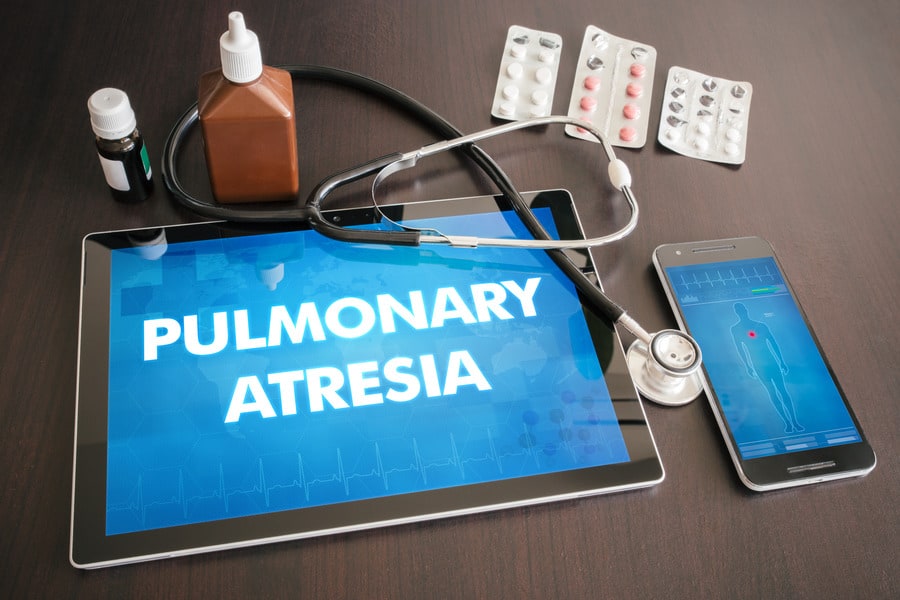Pulmonary atresia is a rare congenital heart defect in which the pulmonary valve does not develop properly. The pulmonary valve, located between the right ventricle and pulmonary artery, allows blood to flow from the heart to the lungs for oxygenation. In pulmonary atresia, the valve’s opening is absent or severely narrowed, restricting blood flow to the lungs.
Overview
Pulmonary atresia can occur in various forms:
- Pulmonary Atresia with Intact Ventricular Septum (PA-IVS): The valve is absent, but the heart’s ventricles are otherwise normal. This form often requires immediate treatment.
- Pulmonary Atresia with Ventricular Septal Defect (PA-VSD): The pulmonary valve is absent or narrowed, and there is a hole in the ventricular septum, allowing blood to mix between the heart’s chambers.
The severity of the condition varies depending on the extent of valve obstruction and other heart anomalies present. Treatment typically involves surgery to improve blood flow to the lungs.
Symptoms
Symptoms of pulmonary atresia can appear shortly after birth:
- Cyanosis: A blue or purple tint to the skin, lips, and nails due to low oxygen levels in the blood.
- Breathing Difficulties: Shortness of breath, rapid breathing, or labored breathing.
- Fatigue: Tiredness and fatigue during feeding or activity.
- Poor Weight Gain: Difficulty gaining weight and slower growth.
- Heart Murmur: An abnormal heart sound detected during a physical examination.
Causes
Pulmonary atresia is a congenital heart defect, meaning it is present at birth. The exact cause is often unknown. However, several factors may contribute:
- Genetic Factors: Genetic mutations or a family history of congenital heart defects may increase the risk.
- Environmental Factors: Exposure to certain environmental factors during pregnancy, such as certain medications or infections, may increase the risk.
- Maternal Health: Conditions like diabetes or lupus in the mother may increase the risk of congenital heart defects.
Risk Factors
Factors that may increase the risk of pulmonary atresia include:
- Family History: A family history of congenital heart defects may increase the risk.
- Maternal Age: Older maternal age may be associated with an increased risk of congenital heart defects.
- Maternal Health Conditions: Conditions like diabetes or lupus may increase the risk.
- Exposure to Certain Substances: Exposure to certain medications, drugs, or alcohol during pregnancy may increase the risk.
How to Avoid It
While not all cases of pulmonary atresia can be prevented, some measures may reduce the risk of congenital heart defects:
- Prenatal Care: Regular prenatal check-ups and screenings can help detect heart defects early.
- Healthy Lifestyle: Maintaining a healthy lifestyle, including a balanced diet and regular exercise, can reduce the risk of complications during pregnancy.
- Avoiding Harmful Substances: Avoiding alcohol, tobacco, and recreational drugs during pregnancy can help reduce the risk of congenital heart defects.
- Managing Chronic Conditions: Proper management of chronic health conditions, such as diabetes, can reduce the risk of heart defects.
When to See the Doctor
If your baby shows signs of pulmonary atresia, such as cyanosis or breathing difficulties, seek medical attention immediately. Early diagnosis and treatment are crucial for improving outcomes.
Treatment
Treatment for pulmonary atresia depends on the severity of the condition and any associated heart defects. It typically involves surgery to improve blood flow to the lungs:
- Balloon Valvuloplasty: A balloon is inserted through a catheter and inflated to widen the pulmonary valve.
- Shunt Procedure: A shunt is placed to divert blood from the aorta to the pulmonary artery, increasing blood flow to the lungs.
- Open-Heart Surgery: In more severe cases, open-heart surgery may be needed to repair the heart’s structure.
- Heart Transplant: In rare cases, a heart transplant may be necessary.
Living with Pulmonary Atresia:
Children who have been treated for pulmonary atresia need lifelong follow-up care with a cardiologist. They may have activity restrictions, need medications, and require additional surgeries or procedures in the future. Regular check-ups are crucial for monitoring heart function, detecting complications, and ensuring optimal long-term outcomes.
Associated Conditions:
Pulmonary atresia may be associated with other heart defects, such as atrial septal defects (ASD) or patent ductus arteriosus (PDA), which can further complicate the condition. These additional defects may need to be addressed during surgical interventions.
Diagnostic Procedures:
Several diagnostic procedures can help confirm a diagnosis of pulmonary atresia and assess the heart’s structure:
- Echocardiogram: Uses sound waves to create detailed images of the heart, showing its size, shape, and how it moves.
- Cardiac Catheterization: A thin tube (catheter) is threaded through the blood vessels to the heart to measure pressure and blood flow.
- Magnetic Resonance Imaging (MRI): Provides detailed images of the heart and surrounding structures.
Long-Term Challenges:
Children with pulmonary atresia may face challenges related to physical development, endurance, and overall health. They may require specialized educational support or accommodations for physical activities. Encouraging a healthy lifestyle and providing emotional support are crucial for their overall well-being.
Research and Innovations:
Ongoing research is focused on improving the diagnosis and treatment of pulmonary atresia and other congenital heart defects. Innovations in surgical techniques, cardiac imaging, and genetic testing may lead to better outcomes for affected children.
Support and Resources:
Parents of children with pulmonary atresia may find it helpful to connect with support groups, organizations, and resources dedicated to congenital heart defects. These communities can offer valuable information, emotional support, and opportunities to connect with other families facing similar challenges.
Pulmonary atresia is a rare congenital heart defect that requires prompt medical attention. With early diagnosis and treatment, many children with pulmonary atresia can lead healthy lives. Proper prenatal care, a healthy lifestyle during pregnancy, and awareness of the risk factors can help reduce the risk of congenital heart defects.









